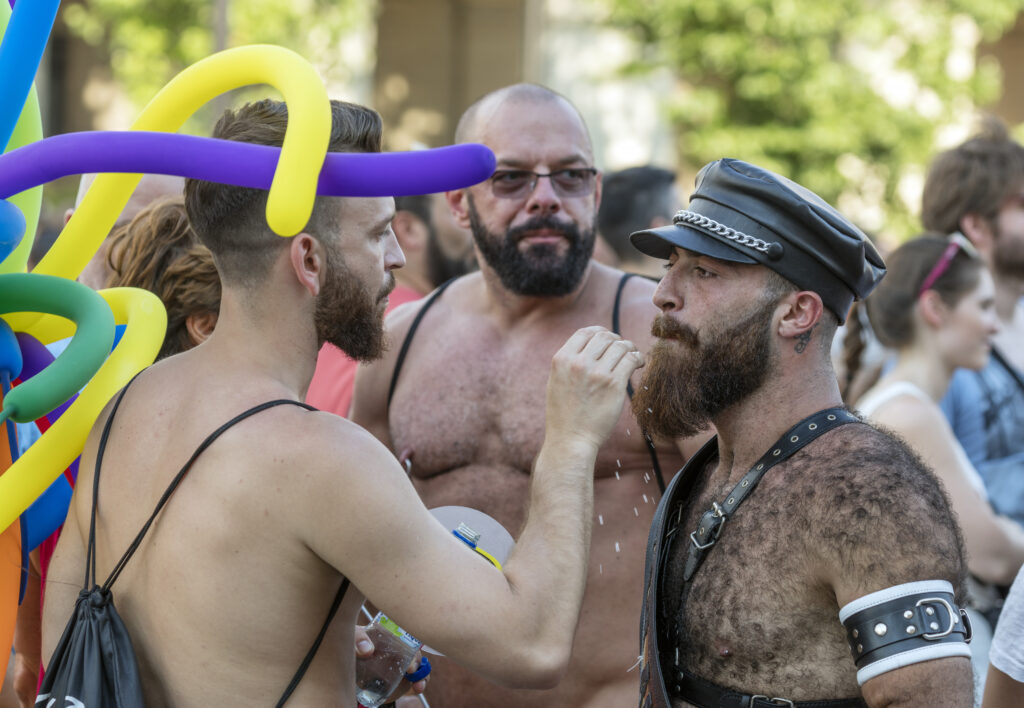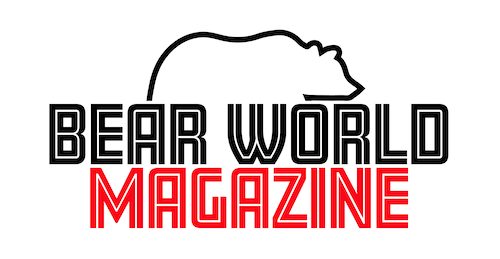Bear Tracks: Hairy Bears
In Western cultures beards and body hair have long been regarded as a mark of masculine virility. In Japanese culture, on the other hand, male body hair is typically met with disgust, is a cause to feel shame, and as something that should be covered when in public. The hairiest men in the world tend to be found among Hispanic, Middle Eastern, and the Ainu of northern Japan. The technical term for hair fetishism is “trichophilia” (love of hair). “Hirsute” describes especially hairy men. (Hirsutism among women is a clinical diagnosis for a condition requiring medical treatment.)
Gay men have long idealized the young, slender, smooth-skinned, androgyne body. In the 1970s and 1980s the gay sexual ideal in the US was the “clone,”, who, at most, sported a moustache. Masculinity is defined by physical traits as well as social values and practices. Hairiness is obviously a physical trait. The smooth-skinned aesthetic continues as seen in the promotion of laser hair removal treatment. Some bears approximate this kind of fastidiousness by keeping their beards trim and by working out. Some bears opt for the “scruffy” look, letting their masculinity hang out. Of course there is push back. Some people see bears as slovenly, lazy, and unhygienic. Preposterously, some even complain that bears “smell bad.” (Some gay men are turned on by the pungent smell of man sweat.)

Heavyset, hairy, bearded men were anathema to this gay aesthetic. Sexual outsiders in this gay culture, self-identifying gay bears proudly defined themselves by their “beards, bellies and body hair.” Richard Bulger, publisher of BEAR Magazine, proclaimed us “naturally masculine” men, building on the “homomasculine” (as defined by gay men) or “hypermasculine” (as defined by heterosexuals) tradition of gay leathermen. Regardless of how we gay men perform gender (that is, how we present our masculinity in behavior and appearance), we continue to be dismissed by the heterosexist prejudice that all gay men, by virtue of our homosexuality, are inescapably “feminine” and can never be “real” men.
Male body hair has gone in and out of fashion over time. The straight male eroticization of female breasts has followed a similar fashion pattern. In the 1920s flat-chested flappers were the last word in sex appeal. When I was growing up in the 1950s and 1960s, the larger a woman’s breasts the better. Marilyn Monroe and Jayne Mansfield were the ideal. In the 1960s the flat-chested ideal experienced a momentary return, for example, in the figure of the model Twiggy. Even her name expressed this. To this day breast augmentation remains a common practice. Like definitions of masculinity, beauty standards are arbitrarily set and change over time. Sexual attraction is, in part, an innate desire beyond conscious control, and in part, shaped by external, cultural factors.
Since I was a teenager, I always look for signs of a hairy chest, thrilled whenever I spot a tuft of fur sticking out over a man’s tee shirt or above the top button of his shirt. I honed this skill watching movies. In the 1940s and 1950s Hollywood often obligated actors to shave their chest hair. Notable exceptions were Montgomery Clift, William Holden, Hugh O’Brian, and Rod Taylor. Even the hairy-chested Kunal Nayyar, who plays Raj Koothrappali on The Big Bang Theory, sometimes appears on-camera with a shaved chest. Swimmers shave their body hair to decrease resistance and increase their speed. Bodybuilders have historically shaved their body hair to show off their sculptured bodies. Nowadays muscle bears keep their body hair, which bearishly sets off their muscled masculinity.

From the start the bear tribe in the US has acknowledged and welcomed “follicularly challenged” bears, known as “behrs.” On rare occasion smooth-skinned and clean shaven bears have been called “manatees.” (Because manatees are also called “sea cows” I personally find this reference offensive.) Black (African American) bears, and to a slightly lesser extent, brown (Hispanic and Latino) bears pass muster with little consideration of their typical lack of body hair. In other cultures, where men do not have body hair—Japanese and Chinese, for example—emphasis is placed on facial hair.
Full beards have gone in and out of fashion since ancient times. In early nineteenth-century America men, from backwoodsmen to presidents, sported beards. By 1820 beards had fallen out of fashion. Communard Joseph Palmer, famous in the nineteenth century famous for being a progressive “hippie” and a founder of the Fruitlands commune, was frequently harassed and questioned for wearing a beard. He was even kicked out of a local church for refusing to shave. By the time of his death in 1873 beards had become widely popular again. He is buried in Leominster in north central Massachusetts, and his grave marker bears a bearded portrait of him with the inscription “Persecuted for Wearing the Beard.” In 1998 I brought my fellow Montachusett Area (“Monty”) Bears to his grave to pay tribute to his “martyrdom.” His story is included in The Bear Book.

In David Yi’s 2019 article “What It’s Like to Be Gay, Hairy and Fetishized,” he writes “[T]he gay community has outwardly made progressive strides towards embracing diversity and inclusivity—expelling the body shame around sexualizing body hair. But what happens behind closed doors is completely different. The queer community may uplift the voices of femme-presenting queer icons or disenfranchised groups but engage with queer dating apps that dictate who‘s invited to the orgy and who need not apply.” Yi seems to be unaware of the history of bears. Bears originally came together precisely because we were outsiders who were not invited to the orgy. We were barred from the bathhouses and when the bathhouses were shut down during the AIDS epidemic we were excluded from the private sex parties which took their place. This stigmatizing rejection was openly practiced and considered socially acceptable. Early bears countered this by adopting a philosophy and spirit of inclusivity, which was practiced in both social and sexual bear spaces. This reminds me of the Jews of a former time in US history, who responded to being excluded from gentile institutions responded by creating their own institutions (such as hospitals and summer resorts). For this they ended up being accused of being “exclusionary.” As Cicero once put it, “O tempora, o mores!”


















